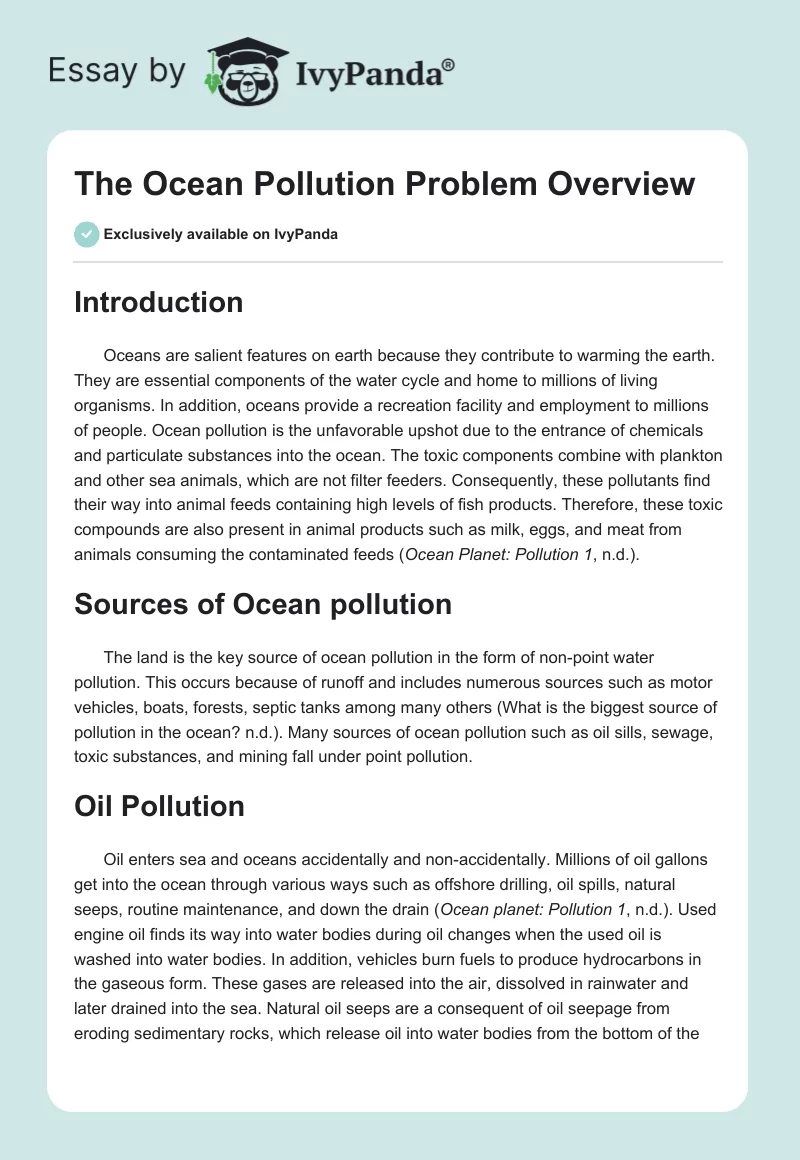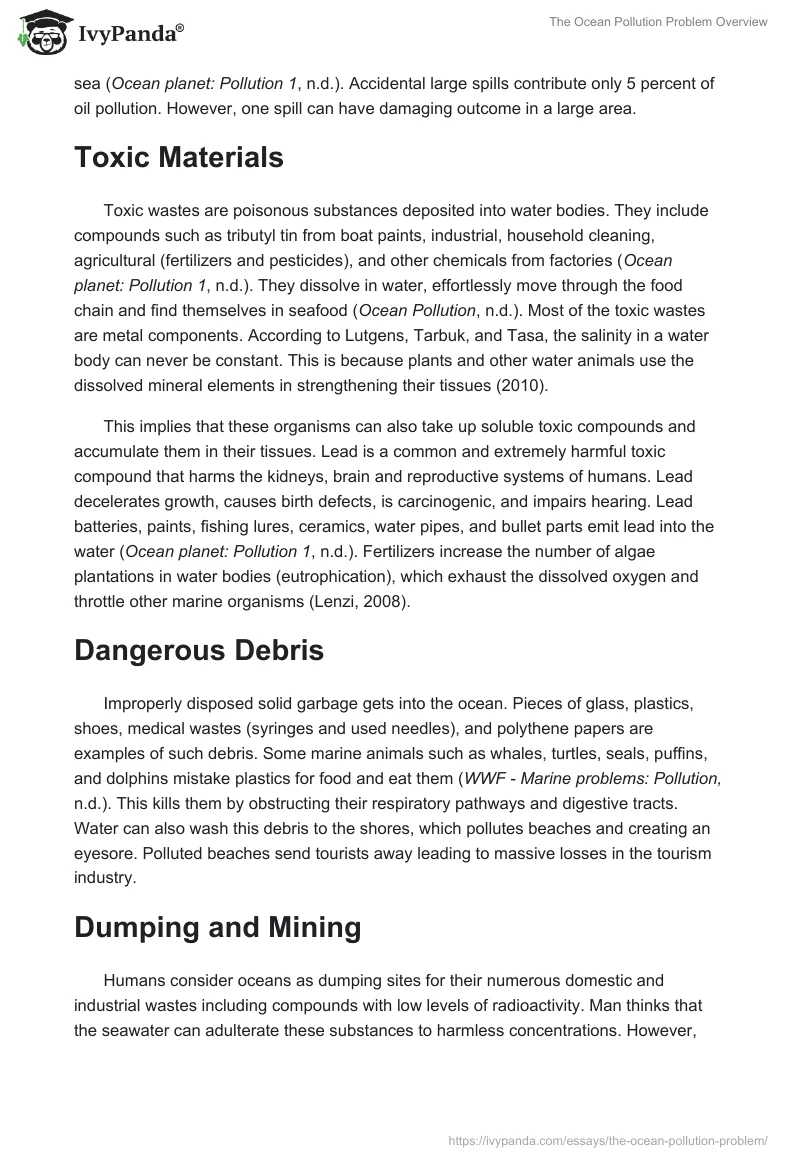Introduction
Oceans are salient features on earth because they contribute to warming the earth. They are essential components of the water cycle and home to millions of living organisms. In addition, oceans provide a recreation facility and employment to millions of people. Ocean pollution is the unfavorable upshot due to the entrance of chemicals and particulate substances into the ocean. The toxic components combine with plankton and other sea animals, which are not filter feeders. Consequently, these pollutants find their way into animal feeds containing high levels of fish products. Therefore, these toxic compounds are also present in animal products such as milk, eggs, and meat from animals consuming the contaminated feeds (Ocean Planet: Pollution 1, n.d.).
Sources of Ocean pollution
The land is the key source of ocean pollution in the form of non-point water pollution. This occurs because of runoff and includes numerous sources such as motor vehicles, boats, forests, septic tanks among many others (What is the biggest source of pollution in the ocean? n.d.). Many sources of ocean pollution such as oil sills, sewage, toxic substances, and mining fall under point pollution.
Oil Pollution
Oil enters sea and oceans accidentally and non-accidentally. Millions of oil gallons get into the ocean through various ways such as offshore drilling, oil spills, natural seeps, routine maintenance, and down the drain (Ocean planet: Pollution 1, n.d.). Used engine oil finds its way into water bodies during oil changes when the used oil is washed into water bodies. In addition, vehicles burn fuels to produce hydrocarbons in the gaseous form. These gases are released into the air, dissolved in rainwater and later drained into the sea. Natural oil seeps are a consequent of oil seepage from eroding sedimentary rocks, which release oil into water bodies from the bottom of the sea (Ocean planet: Pollution 1, n.d.). Accidental large spills contribute only 5 percent of oil pollution. However, one spill can have damaging outcome in a large area.
Toxic Materials
Toxic wastes are poisonous substances deposited into water bodies. They include compounds such as tributyl tin from boat paints, industrial, household cleaning, agricultural (fertilizers and pesticides), and other chemicals from factories (Ocean planet: Pollution 1, n.d.). They dissolve in water, effortlessly move through the food chain and find themselves in seafood (Ocean Pollution, n.d.). Most of the toxic wastes are metal components. According to Lutgens, Tarbuk, and Tasa, the salinity in a water body can never be constant. This is because plants and other water animals use the dissolved mineral elements in strengthening their tissues (2010).
This implies that these organisms can also take up soluble toxic compounds and accumulate them in their tissues. Lead is a common and extremely harmful toxic compound that harms the kidneys, brain and reproductive systems of humans. Lead decelerates growth, causes birth defects, is carcinogenic, and impairs hearing. Lead batteries, paints, fishing lures, ceramics, water pipes, and bullet parts emit lead into the water (Ocean planet: Pollution 1, n.d.). Fertilizers increase the number of algae plantations in water bodies (eutrophication), which exhaust the dissolved oxygen and throttle other marine organisms (Lenzi, 2008).
Dangerous Debris
Improperly disposed solid garbage gets into the ocean. Pieces of glass, plastics, shoes, medical wastes (syringes and used needles), and polythene papers are examples of such debris. Some marine animals such as whales, turtles, seals, puffins, and dolphins mistake plastics for food and eat them (WWF – Marine problems: Pollution, n.d.). This kills them by obstructing their respiratory pathways and digestive tracts. Water can also wash this debris to the shores, which pollutes beaches and creating an eyesore. Polluted beaches send tourists away leading to massive losses in the tourism industry.
Dumping and Mining
Humans consider oceans as dumping sites for their numerous domestic and industrial wastes including compounds with low levels of radioactivity. Man thinks that the seawater can adulterate these substances to harmless concentrations. However, the processes in the ocean concentrate some of these harmful substances leading to ocean pollution.
Oceans, on the other hand, are unexploited sources of some minerals and ores. The building industry, for example, obtains building materials such as sand and gravel from the coast and the surrounding coral reefs (Ocean planet: Pollution 1, n.d.). This is a common phenomenon in island countries with inadequate internal reserves. Mining contributes to water pollution by deposition of particulate matter and erodes coastal beaches. Manganese, nickel, cobalt, and copper are some of the metals available in the “abyssal mud of the ocean’s deepest basins” (Ocean planet: Pollution 1, n.d.). Mining under the water is expensive compared to the conventional mining process on land. However, it is only a matter of time before new technology in mining under the water comes up.
Sewage
Untreated and under-treated sewage flows into oceans causing pollution. For example, in the Mediterranean Sea receives about 80% of untreated sewage (Marine problems: Pollution, n.d.). This causes outbreaks of water-borne human diseases and eutrophication. Wastewater from the land drains into water bodies such as rivers and lakes, which drain into seas and oceans.
Ways of Preventing Ocean Pollution
Boat engines pollute oceans from the gasoline emitted. However, boating is an inevitable practice in some instances. Some precautions can help minimize boating pollution such as turning on the boat engine when it is necessary. Gasoline ought to be stored away from direct sunlight to minimize evaporation and air pollution, which comes back to the ocean as rainwater. It is also essential to replace boat engines regularly and ensure that they are in a good working condition. Ensuring that only clean water gets into the oceans goes a long way in limiting wastewater pollution. This is possible by creating tanks with the capability of harvesting all rainwater runoffs and treating it before discharging it into water bodies.
Setting up rules and regulations that restrict dumping of wastes is an effective way of preventing pollution. The “London Convention,” a United Nations directed pact prevents dumping of wastes and regulates the deposition of certain substances (Ocean planet: Pollution 1, n.d.). In addition, the federal and international regulations forbid discarding plastic trash overboard. Consequently, the United States Navy ensures that no trash is discarded overboard by providing onboard processors that compress and disinfect plastic rubbish. The establishment of cleaning programs can help get rid of debris from water bodies. A good example is the Center for Marine Conservation’s International Coastal Cleanup, a program that unites various volunteers worldwide in cleaning up water bodies (Ocean planet: Pollution 1, n.d.).
Conclusion
Ocean pollution is a serious problem that ought to be controlled because water is an extremely essential component for the sustenance of life. Some sources of pollution are controllable, whereas the natural sources are uncontrollable. It is, therefore, necessary for humankind to do everything to minimize ocean pollution due to the controllable sources.
References
Lenzi, M. (2008). Resuspension of sediment as a method of managing eutrophic lagoons. In Hofer, N. T. (Ed.), Marine Pollution: New research (pp. 15-23). New York: Nova Science Publishers.
Lutgens, F. K., Tarbuk, E.J., & Tasa, D. (2010). Foundations of earth science (6th ed.). New Jersey: Pearson College Division.
Marine problems: Pollution. (n.d.). Web.
Ocean planet: Pollution 1. (n.d.). Web.
Ocean pollution. (n.d.). Web.
What is the biggest source of pollution in the ocean? (n.d.). Web.


